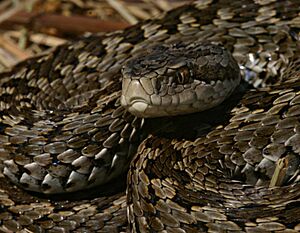Hungarian meadow viper facts for kids
Quick facts for kids Hungarian meadow viper |
|
|---|---|
 |
|
| Conservation status | |
| Scientific classification |
|
| Kingdom: | Animalia |
| Phylum: | Chordata |
| Class: | Reptilia |
| Order: | Squamata |
| Suborder: | Serpentes |
| Family: | Viperidae |
| Genus: | Vipera |
| Species: | |
| Subspecies: |
V. u. rakosiensis
|
| Trinomial name | |
| Vipera ursinii rakosiensis Méhelÿ, 1893
|
|
The Hungarian meadow viper (Vipera ursinii rakosiensis), also called the Danubian meadow viper, is a very rare and venomous snake. It is one of eight types of Vipera ursinii subspecies. This special snake is mostly found in Hungary. It is the most endangered animal in the entire Pannonian Basin, a large area in Central Europe. A Hungarian scientist named Lajos Méhelÿ first officially recorded it in 1893. By 2004, experts thought there were fewer than 500 of these vipers left in Hungary.
Contents
About the Hungarian Meadow Viper
What Do They Look Like?
Adult Hungarian meadow vipers are usually less than 50 centimeters long. Their heads look like a triangle. This shape comes from their venom glands, which are near their temples.
The main color on their backs can be light grey or straw-colored. They have a dark zig-zag pattern along their back. This pattern has lighter lines around its edges. On the sides of their bodies, they have round patches. These patches are the same color as the zig-zag on their backs. Their tails are short. A female's tail gets thin very quickly.
These vipers look a bit like the common European adder (Vipera berus). However, Hungarian meadow vipers are shorter. Male and female vipers have the same colors.
Life Cycle and Habits
Hungarian meadow vipers are diurnal animals. This means they are active during the daytime. They mostly eat lizards and insects, like locusts. From October to March, they hide in underground holes.
Their mating season is in late March and early April. Male vipers often fight each other to win over females. Females lay about 4 to 16 eggs. These eggs hatch in late July. Baby vipers are 100 to 160 millimeters long when they are born. They shed their skin just a few minutes after hatching. In their first year, they shed their skin every 4 to 6 weeks. As they get older, they shed less often. Adult vipers shed their skin three times a year.
Where Do They Live?
Hungarian meadow vipers usually live in flat plains. In the past, they were found in parts of Austria, Hungary, and Romania. They once lived all over the Great Hungarian Plain. But now, they are very close to disappearing.
Today, you can find them in small groups. These groups live in the Hanság area and in the Danube-Tisza Interfluve. The Danube-Tisza Interfluve is the land between the Danube and Tisza rivers. Specifically, they live in the Kiskunság region. There are fewer than ten known groups in the Kiskunság. Only two groups are known in the Hanság.
Protecting These Rare Snakes
The number of Hungarian meadow vipers started to drop about 300 years ago. The Danube-Tisza Interfluve used to have lots of water. Large areas were covered by pastures, which are grassy fields for animals. By the early 1900s, there were fewer farm animals in these areas. Many pastures were plowed to grow crops instead. This changed the landscape a lot.
Around the same time, people started to control water flow in the interfluve. These changes made the vipers' habitat much smaller. Also, until the mid-1900s, people hunted these vipers. They also caught them illegally to sell them.
The Hungarian meadow viper has been a protected species in Hungary since 1974. It is the most endangered animal in the country. Because it is so important to protect, its conservation value is 1 million Hungarian forints.
The CONVIPURSRAK Project
In 2008, the European Commission started a project called CONVIPURSRAK. This project was part of The LIFE Programme. Its goal was to help the Hungarian meadow viper. The project finished in 2012. Even though the vipers were already protected, their numbers were still going down.
The project aimed to make their habitat bigger. They did this by rebuilding grasslands. They also released vipers into natural areas. The plans also included a program to teach people about the vipers. This was done with the help of zoos.
The project was very successful. It helped increase the number of vipers. It also made their habitat almost 400 ha bigger. National parks in the Hanság and Kiskunság now manage more land. The project also helped move forward the program to breed vipers in zoos. Many improvements were made. For example, the Hungarian Meadow Viper Conservation and Exhibition Centre was fixed up. A center to breed food for the vipers was also built at the Budapest Zoo.


